Statistics Estonia gave an overview of the preparations for the next population census
The next population and housing census in Estonia will, for the first time in Estonian history, take place on the basis of registers, i.e. no information is asked from people directly, the results are put together based on the data stored in state databases. This is what gave the census the name Register-Based Population and Housing Census (with the abbreviation REGREL in Estonian).
The register-based population and housing census will take place in 2020. Preparations for it started in as early as 2010. In order to conduct the census successfully, Statistics Estonia needs information from at least 17 state registers. In today’s press conference, Andres Oopkaup, Director General of Statistics Estonia, gave an overview of the preparations for REGREL, Diana Beltadze, the REGREL project manager, gave an overview of the first trial census taking place in 2016, and Enel Pungas, Head of the Population Procedures Department of the Ministry of the Interior, talked about improving the data quality of the Population Register.
Andres Oopkaup explained that using registers for the census is a new topic for Estonia, but the method has been used already for decades in Scandinavian countries. “A census that is based on register data is, in the long run, more resource efficient for the state, but requires data organisation works in databases,” Oopkaup explained.
In 2016, Statistics Estonia will conduct a REGREL trial (with the census moment 31.12.2015) in order to test the concept of a register-based census. Data capture activities for the census trial have ended and in the course of it, data were collected from 22 registers. The general population of the census, both with regard to the population and housing, has been defined and problematic areas have been determined, now needing solutions. Diana Beltadze admitted that, right now, registers do not include all the characteristics about the entire population which are necessary for conducting the census and data are not updated fast enough in the registers. “The inhabitants’ obligation to regularly check and specify their data in the Population Register plays an important part in improving the data quality, timeliness and coverage of registers,” Diana Beltadze explained.
As an example, Diana Beltadze explained that in a register-based census, a household is formed of persons living in the same dwelling. The forming of households and families is based on the residents’ place of residence registered in the Population Register. Based on the place of residence in the Population Register, there are very many lone parent families in Estonia, compared to the family distribution of the previous population and housing census conducted in 2011 (PHC2011), which used data based on residents’ statements. “When a child, along with one of the parents, is registered into a place of residence that enables getting into a desired kindergarten or school, and the rest of the family remain registered in a different place of residence, one family will become two lone parent families,” Beltadze explained.

One of the important databases used in the register-based census is the Population Register. Enel Pungas, Head of the Population Procedures Department of the Ministry of the Interior, discussed supplementing the data of the Population Register. “We are planning to add data of a million civil status documents,” Pungas said. With this, all data from civil status documents created in Estonia since 1926 will be digitally stored. “Thanks to this, procedures will be simpler: the users of the Population Register will be able to get all the civil status data they need from the register and they will not have to make queries to the archive nor wait until the data they need are entered,” Enel Pungas added.